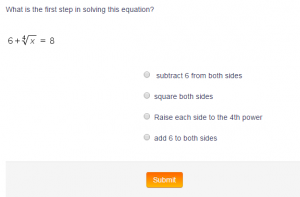 Edsel Ford Math teacher Mrs. Angela Maynor recently created a virtual lesson using Moodle (iLearn). Her lesson consisted of several content pages that introduced the concept of radical equations.
Edsel Ford Math teacher Mrs. Angela Maynor recently created a virtual lesson using Moodle (iLearn). Her lesson consisted of several content pages that introduced the concept of radical equations.
Her lesson is expertly organized, modeling sequences used by effective teachers.  In the early pages of the lesson, Mrs. Maynor introduces the concept of radical equations and walks students through step by step to solving the equations. Subsequent pages take students through steps using several examples and even embedded tutorial videos hand-picked by the content expert herself. Once students have explored the concept, which Maynor has designed to allow them to navigate through freely, students move on to progressively more difficult concept check questions.
In the early pages of the lesson, Mrs. Maynor introduces the concept of radical equations and walks students through step by step to solving the equations. Subsequent pages take students through steps using several examples and even embedded tutorial videos hand-picked by the content expert herself. Once students have explored the concept, which Maynor has designed to allow them to navigate through freely, students move on to progressively more difficult concept check questions.
Once students have completed the basic concept questions, they move through a series of problems that require them to apply the knowledge they have gained in the lesson. Students must answer the questions correctly in order to move on in the lesson.
The virtual lesson is replete with self-assessment, as students are asked to self-assess on a 4-point scale. This models a process with which they are familiar as students at Edsel Ford High School.  Unbeknownst to students, those who assess themselves at a 1 or 2 (lower levels of proficiency) are then asked to describe their perceived deficiencies with regard to the lesson material, while those who assess themselves at higher levels are taken to the end of the lesson.
Unbeknownst to students, those who assess themselves at a 1 or 2 (lower levels of proficiency) are then asked to describe their perceived deficiencies with regard to the lesson material, while those who assess themselves at higher levels are taken to the end of the lesson.
As impressive as the lesson is, the most significant aspect is in the ways it changes Mrs. Maynor’s role as a teacher. Since the lesson is prepared in advance with embedded assessment and multimedia, Maynor spent most of her time dealing individually with students and small groups. The virtual lesson freed her from being tied to the front of the room presenting material, to being able to differentiate for students and address needs on a personal basis. Students also benefit from the self-paced nature of the lesson, which no longer left behind those who had significant conceptual misunderstandings, and also didn’t hold back those who could achieve proficiency more quickly.
This is a great example of a teacher using technology in a way that transforms the learning experience for students, going beyond simple replacement of paper and pencil with a computer, and instead harnessing the emergent benefits of the technological tool.

